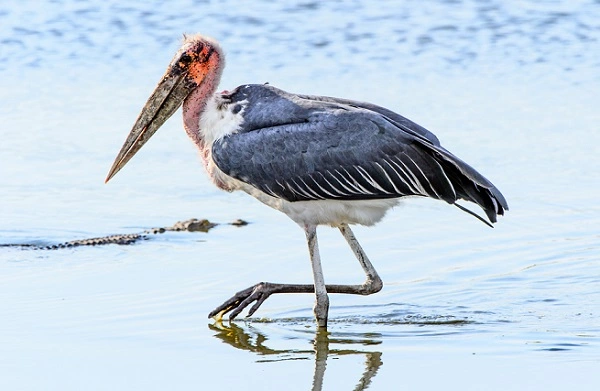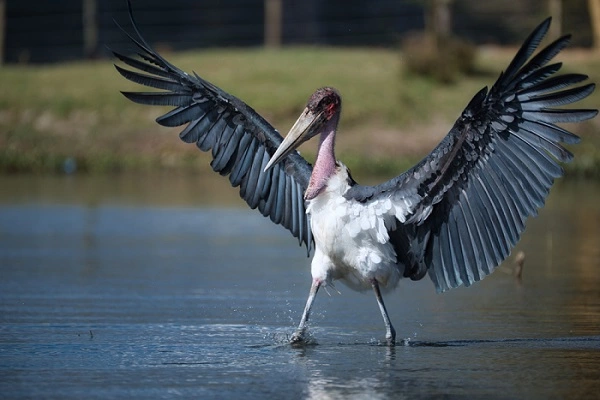Do you know what a marabou stork is? They are one of the most interesting looking birds in the world, with their long legs and neck, and plush plumage. These amazing animals can be found in several African countries, and they play an important role in the ecosystem. Learn more about these fascinating creatures in today’s blog post.

Marabou Stork Description
The Marabou Stork is a massive bird, with a wingspan of up to 3.6m (12 ft) and weighing up to 11kg (24 lb). It has a bare head and neck, which are grey-black in colour, and a long, black beak. The Marabou Stork’s back and wings are white, while the rest of its body is pale grey. It has long legs, with black feet. Marabou Storks are found in Africa, south of the Sahara desert. They often congregate near water, where they feed on carrion and other small animals. Marabou Storks are scavengers, and will often follow vultures to feeding sites. However, they will also hunt small mammals and reptiles. Marabou Storks are not migratory birds, but they will make local movements in response to changes in food availability. Marabou Storks are usually solitary birds, but they will form pairs during the breeding season. Marabou Storks build nests in trees, using sticks and other materials. Both parents help to incubate the eggs (usually 2-3), which hatch after about 30 days. The chicks fledge after about 60 days, but they remain dependent on their parents for several months. Marabou Storks reach sexual maturity at 4-5 years of age. The Marabou Stork is classified as Least Concern by the IUCN Red List of Threatened Species. However, it is thought to be declining in numbers due to habitat loss and hunting pressure.
Marabou Stork Habitat
The Marabou Stork is a large bird that often inhabits wetland areas. These birds are most commonly found in Africa, although there are reports of Marabou Storks being seen as far away as India. Marabou Storks typically live in small flocks, although they will sometimes form much larger roosting groups. The Marabou Stork is a scavenger, and it is not uncommon for these birds to be seen following vultures in order to feed on the carcasses of dead animals. Marabou Storks are also known to eat reptiles, fish, and small mammals. The Marabou Stork has a very unique appearance, with its long neck and bald head. These birds are also quite tall, with some adults standing over six feet tall. Marabou Storks are not presently considered to be endangered, although their habitat is under threat from human development.
Marabou Stork Diet
Marabou storks are scavengers and will eat just about anything. Their diet consists mostly of carrion, but they will also eat small mammals, reptiles, insects, and scraps from human garbage. In Africa, they have been known to kill young lambs and goats. Marabous will wade into water to catch fish or collect food that has floated to the surface. They often team up with vultures to feed on larger carcasses. Marabous have even been known to eat baby hippos, although this is rare. The Marabou stork is a large bird with a wingspan of up to 3.6 m (12 ft). It is found in sub-Saharan Africa and is the only member of the genus Leptoptilos. The Marabou stork is a widespread species, occurring across most of sub-Saharan Africa. It prefers open habitats such as savanna, steppe, and grassland, but can also be found in forest edges and riverine forest. The Marabou stork is a largely sedentary species, although local movements do occur. The Marabou stork is a social bird, often seen in groups of up to 100 birds. It has various calls which include a guttural croak and a trumpeting sound. Marabous are sometimes nicknamed “undertakers” because they often follow lions and other predators in order to eat the leftover scraps from their kills. Marabous are also known to steal food from other animals, including humans. In some African cultures, the Marabou stork is considered to be a bad omen and is feared by many people.

Marabou Stork Size
Marabou storks are large birds, with a wingspan that can reach up to 3.6 meters (12 feet). They are one of the heaviest flying birds, with males averaging around 9 kg (20 lbs) and females around 7 kg (15 lbs). Marabou storks are native to Africa, where they can be found in woodlands and wetlands. They are scavengers, feeding on carrion as well as small mammals, reptiles, and amphibians. Marabou storks often follow vultures to feeding sites. Marabou storks are not currently considered endangered, although their numbers have declined due to habitat loss and hunting.
Marabou Stork Lifespan
The Marabou Stork is a large bird with a wingspan of up to 3.6 meters. It is found in Africa, where it feeds on carrion and garbage. The Marabou Stork has a lifespan of up to 50 years in captivity, although the average lifespan in the wild is unknown. The Marabou Stork is a protected species in many countries and is listed as endangered by the IUCN. The main threats to the Marabou Stork are habitat loss and hunting.
Marabou Stork Behavior
Marabou storks are large wading birds that are found throughout sub-Saharan Africa. They are most commonly seen near water, where they feed on fish, amphibians, and reptiles. Marabou storks are also known to eat carrion, and they will often follow vultures to feeding sites. Marabous typically roost in trees, but they will sometimes build nests on the ground. These nests are usually made of sticks and twigs, and they are often lined with leaves or grass. Marabous typically lay two to four eggs per clutch, and the incubation period lasts around 30 days. Once the chicks hatch, they are altricial, meaning that they are born naked and helpless. The chicks will remain in the nest for several weeks before fledging. Marabous reach sexual maturity at three to four years of age.
Marabou Stork Speed
Marabou storks are among the largest flying birds, with a wingspan of up to 3.6 m (12 ft). They are widespread in sub-Saharan Africa, where they typically inhabit wetland habitats. Marabous are known for their slow, methodical movements and their elegant flight. However, they are also capable of high speeds, reaching up to 70 km/h (43 mph) in level flight. Marabous use their speed to help them catch prey, such as small mammals and reptiles. Their long legs and necks give them an advantage when hunting in open areas. Marabou storks are intimidating predators, but they also play an important role in the ecosystem by scavenging for carrion.
Marabou Stork Hunting
Marabou storks are scavengers, feeding on the carcasses of animals. They are also known to hunt live prey, particularly when food is scarce. Marabou storks will typically target small mammals and reptiles, though they have been known to kill and eat young birds as well. When hunting, Marabou storks will use their sharp beaks to puncture their prey. They will then use their long necks to swallow their prey whole. Marabou storks typically hunt alone, though they have been known to team up with other Marabou storks in order to take down larger prey. Marabou storks typically hunt during the daytime, though they have been known to hunt at night as well. Marabou stork hunting is not constrained by season, though the birds are more likely to hunt when food is scarce. Marabou storks typically nest in trees, often near water sources. The birds typically lay two eggs per clutch, though occasionally only one egg will be laid. Marabou stork chicks are born blind and cannot fly. They are reliant on their parents for food and shelter. Marabou stork chicks typically fledge at around twelve weeks of age. Once they fledge, Marabou stork chicks are able to fly and fend for themselves. Marabou storks typically live for around twenty years in the wild. Marabou storks are not currently considered to be endangered. However, the species is declining due to habitat loss and degradation. Marabou storks are protected under the Convention on International Trade in Endangered Species of Wild Fauna and Flora (CITES). Marabou storks are also protected under the African-Eurasian Migratory Waterbird Agreement (AEWA).
Conclusion
The marabou stork is an impressive bird. It’s one of the largest in the world, with a wingspan that can reach up to 10 feet wide. It’s also bald, which gives it a rather unique appearance. Despite its size and odd features, this stork is actually quite gentle and makes for a fascinating subject of study. If you’re interested in learning more about these birds or want to see some amazing photos, be sure to check out some of the links below.
Frequently Asked Question


